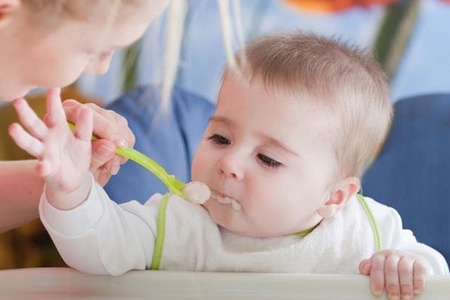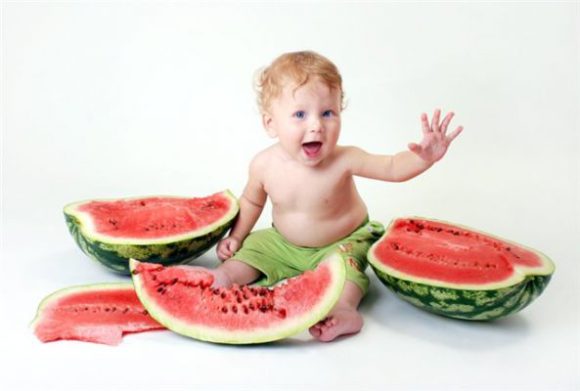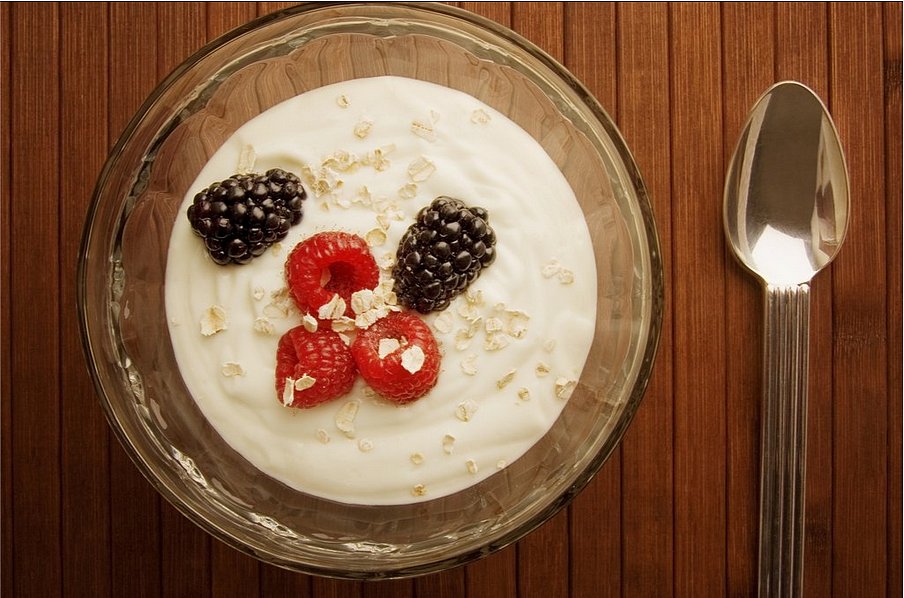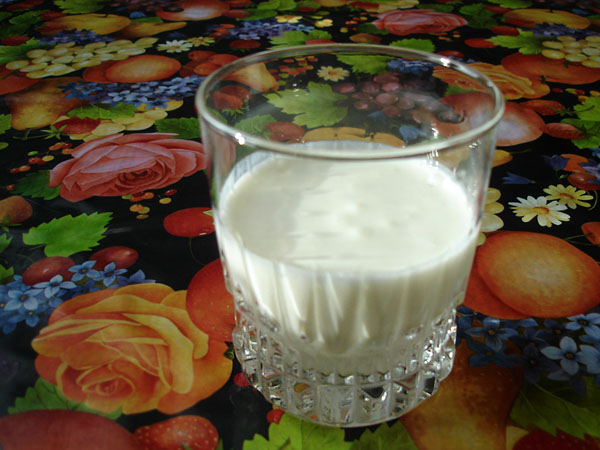The diet of a nine-month-old baby is almost as varied as the menu of an adult, with the exception of some products. Gradual complementary foods that began with a baby who is on breastfeeding, from six months, and on artificial feeding- from three months, allowed to significantly expand the range of available and healthy meals. However, there is a list of dangerous products that can cause intestinal disorders or allergic reactions.
Basic Rules
The daily volume of food consumed by a 9-month-old infant averages 1 liter, and the proportion of breast milk or formula is reduced to 25–30% of the intended diet, giving way to new dishes. For the ninth month, the baby gains about 450 g of weight with proper feeding and following some rules:
- the baby needs a six-time meal;
- the diet must necessarily include cereals, meat, fish, vegetables, fruits and dairy products;
- salt should be used carefully, since its excess has a negative effect on a growing organism;
- boiled vegetables (potatoes, carrots) do not have to be mashed, you can cut them into small cubes, which the baby can easily chew with his gums;
- it is necessary to teach the child to eat on his own, putting him at a special table and giving a cup instead of a bottle;
- if the child needs snacks, then you can offer children's cookies, which dissolve easily in saliva, preventing the baby from choking. It also relieves irritation and pain from swollen gums.
Being at the table next to adults, the baby already understands that eating is not just a physiological need, but a tradition that promotes human communication. Therefore, he should also be given cutlery (preferably special for children) and beautiful bright dishes (preferably ceramic). And a table for a week will help to create a healthy and balanced diet for a child at 9 months:
| Breakfast (07:00) | Second breakfast (10:00) | Afternoon snack (12:00) | Lunch (15:00) | Dinner (18:00) | Second dinner (20:00) | |
|---|---|---|---|---|---|---|
| I | milk or mixture | porridge + puree (apple) | puree soup (chicken + vegetables) | juice (carrot) | puree (cabbage) + cracker | milk or mixture |
| II | porridge (rice) + egg yolk (1/2) | + juice | baked apple | puree (potato + spinach) | ||
| III | porridge (oatmeal) + cracker | puree (vegetable) + cutlets (chicken) | Apple juice) | cottage cheese + fruit | ||
| IV | buckwheat with pumpkin + juice (berry) | pumpkin cutlets + meat puree (veal) | croutons + kefir | puree (cauliflower) | ||
| V | oatmeal + juice | fish + porridge (rice) + compote (pear) | kissel (strawberry) | vegetable puree | ||
| VI | porridge (semolina) + quail yolk | boiled zucchini + veal + compote (apple) | puree (pumpkin + apple) | casserole (carrot + cottage cheese) | ||
| VII | porridge (rice) + fruit puree | mashed potatoes (potatoes) + soup with meatballs | juice (apple + carrot) | kefir |
When feeding, it is important to follow the needs of the child: hunger should not be allowed, but you should not force the baby to eat against his will.
Kashi

Since the baby is already old enough, and his digestive system has become stronger, there are very few “forbidden” cereals left. Cereals saturated with carbohydrates, fats and vitamins become the main source of energy for the baby. According to the degree of usefulness for a nine-month-old child, the following cereals occupy the pedestal:
- buckwheat is very easy to digest and has a positive effect on the development of all internal organs. It is the most nutritious, contains the largest amount of iron, potassium, phosphorus and magnesium in comparison with other cereals;
- oatmeal - the favorite porridge of the British is inferior to buckwheat only in terms of the amount of vegetable fats it contains. Oatmeal, unlike buckwheat, can be easily made sweet and appetizing by adding fruit puree, which will make it more attractive to the baby;
- rice - despite its nutritional value, contains fewer minerals and vitamins. Rice porridge is recommended to be given to babies once a week, as frequent use can cause stool retention.
Of the “forbidden” cereals, corn and wheat remain, since they are hard to digest and contain fewer useful trace elements compared to the “golden three”.
Many pediatricians also argue about semolina, although in Soviet time it was the first food for a newborn after breast milk. Now doctors say that there are very few nutrients and useful substances in this cereal, but there is a lot of mucopolysaccharide gliodin, which causes necrosis of the intestinal villi. According to experts, the frequent use of semolina leads to a violation of the microflora of the gastrointestinal tract. As a result, the absorption of calcium and vitamin D worsens, which increases the risk of developing colitis, chronic gastritis, rickets, and even cancer.
Based on this, doctors advise starting to feed only a one-year-old baby with semolina, and up to this age it is only allowed to “dilute” the diet with it twice a month, especially since the nutritional value this cereal is quite low. It should be noted that this medical opinion is not official.
Children with diathesis need to eat porridge with the addition of vegetable oil.
Meat and fish
Some cereals and milk mixtures are not able to provide the body of a nine-month-old baby with a sufficient amount of protein and amino acids that play important role in the development of the muscular, skeletal and immune systems. Therefore, fish or meat (low-fat, unsalted) should be present in the children's diet every day. Meat (chicken, turkey, veal, rabbit) can be boiled and then baked in the oven, thus giving the dish an appetizing taste. When choosing the consistency of the dish, it should be borne in mind that it is more convenient for the baby to eat cutlets and well-chopped meat puree, but in the ninth month you can “tear” the meat into small pieces.

According to statistics, about a third of babies eat fish dishes reluctantly. Therefore, at first, you can give fish puree mixed with vegetable (potato or cabbage). Gradually, the child will get used to the taste of fish and will not reject seafood. It is best to buy low-fat river fish (carp or pike perch), which must be boiled, separated from the bones and chopped twice in a blender or meat grinder.
When cooking fish, you need to throw it into boiling water. Juices are preserved under the crust of sharply curdled protein, due to which the carcass will be juicier and softer.
Vegetables and fruits
Thinking about how to feed a child at 9 months old, it is worth noting that there are practically no forbidden vegetables, which cannot be said about fruits. The risk of allergies is still present, so citrus fruits, as well as red berries (raspberries, strawberries) can be dangerous. They are recommended to be introduced into the diet gradually and in small doses. It is forbidden to give grapes up to two years, because it causes fermentation in the intestines, which is fraught with gas and microflora disturbance.
The table will help to recognize which dishes can cause stool disturbance, and which foods will fix it:
Puree satisfies hunger most quickly, as it instantly envelops the walls of the stomach. However, it is this consistency that can cause constipation. Milk also delays stool. For constipation, doctors advise giving the baby more fluids: water, juices and non-concentrated herbal teas. When choosing the latter, you should consult with a specialist. For example, mint and chamomile tea will only exacerbate a delicate problem.
Dairy products
An abundance of protein in the baby's body can cause various problems in the future, in particular, metabolic disorders and high blood pressure. Therefore, the introduction of fermented milk products into complementary foods for a six-month-old baby is unreasonable. The nutrition of a child at 9 months, when he is already familiar with vegetables, cereals and fruits, may include cottage cheese, kefir and fermented baked milk, but with some reservations:
- it is best to give these products for dinner;
- complementary foods with cottage cheese begin with 3–5 g, and by the end of the ninth month, you can increase the dose to 15 g daily, and by the age of 50 g;
- you can either buy special children's cottage cheese, or cook it yourself: sour (prepared from 1% kefir) or calcined (prepared from calcium chloride, which is sold in a pharmacy);
- complementary foods with kefir start with 20 ml and gradually increase to 100 ml daily.
Replenishing the child's menu at 9 months with fermented milk products, you need to carefully monitor his condition. If the baby likes such dishes, and allergic reactions are not observed, then you can gradually increase the volume of their consumption.
By 9 months the main complementary foods have already been introduced, so the expansion of the child's diet continues. It is important to know that at this age the consistency of the products should change from homogenized to finely and coarsely ground.
A meat dish for an older child can be offered in the form of meatballs, which diversifies the child's diet and stimulates the formation of chewing skills. Canned meat industrial production for children over 8 months. - coarsely ground, spices and spices (white pepper, celery, parsley, dill, onion, basil, thyme) can be added to them.
The volume of fish puree increases to 60 g per day by 12 months. Fish is given 2 times a week boiled without broth (instead of meat).
At this age, you can offer your child baby vermicelli.
The number of children's cookies and crackers is increased up to 10-15 g per day (2-3 cookies).
By the year, it is useful to add finely chopped fresh garden greens (dill, parsley) to various dishes, which significantly enriches the diet with vitamins and minerals.
Approximate diet for a 12 month old
| breakfast 8 ocloc'k |
Dairy-free or milk porridge* Butter Boiled egg yolk fruit puree |
150-200 g about 1 tsp 1/2 piece 50 g |
| dinner 12 hours |
vegetable puree Vegetable oil Meat puree (meatballs) or fish Bread / cracker Compote |
180 g |
| afternoon tea 16 hours |
Breast milk (kefir or yogurt)** Cottage cheese fruit puree baby biscuits |
100 g 50 g 50-70 g 2 pcs |
| dinner 20 hours |
Vegetables or porridge** Meat puree Vegetable oil Fruit juice |
180 g 20 g 1/2 tsp 50 ml |
| before bedtime 23 hours |
Breast milk (DMS)*** | 200 ml |
* - dairy-free porridge should be diluted breast milk or infant formula given to a child. Milk porridge is diluted with water.
** - the daily volume of kefir or yogurt can be up to 200 ml,
*** - infant formula
An approximate diet for a 12-month-old child with an allergy to cow's milk proteins:
| breakfast 8 ocloc'k |
Dairy-free porridge* Vegetable oil fruit puree |
150-200 g about 1 tsp 50 g |
| dinner 12 hours |
vegetable puree Vegetable oil Meat puree/meatball Bread / cracker Compote |
180 g about 1/2 tsp 50-70 g 10 g 50 ml |
| afternoon tea 16 hours |
fruit puree cracker |
150-180 ml |
| dinner 20 hours |
Vegetables or dairy-free porridge** Vegetable oil Meat puree Fruit juice |
180 g about 1/2 tsp 30-40 g 50 ml |
| before bedtime 23 hours |
Breast milk or medicated formula for babies with cow's milk protein intolerance | 200 ml |
* - Dairy-free porridge should be diluted with breast milk or therapeutic mixture for children with intolerance to cow's milk proteins.
** - you can either alternate porridge or vegetables, or offer a mixed dish - porridge with vegetables.
The materials were prepared by employees of the Healthy and Sick Child Nutrition Department of the Scientific Center for Children's Health and are based on the recommendations given in " National Program optimization of feeding of children of the first year of life in Russian Federation”, approved at the XVİ Congress of Pediatricians of Russia (02.2009)
A 9-month-old child is already actively exploring environment begins to walk, understands the speech addressed to him. Its nutrition is also becoming diverse, the list of new products is expanding. Breast milk is still included in the menu, but is not as important as complementary foods.
The diet of the child by 9 months. includes almost all major products. All instant cereals, vegetable and meat dishes, fruits, bread are used. The list of products that are offered at this age does not differ from the type of feeding. The difference is only in quantity. For formula-fed babies, larger servings are offered. This is primarily due to early introduction complementary foods and an increased need for a vitamin-mineral complex.
It is this time that is favorable for introducing cottage cheese, kefir and other fermented milk products into the diet.
If you introduce such complementary foods earlier, then there will be an excess of protein in the body, which will negatively affect the functioning of the organs involved in metabolic processes. The risk of developing allergies is also high.
A day for a 9 month old child. you can give cottage cheese no more than 50 grams. Kefir begins to be given in small portions (20-30 ml), gradually increasing the volume to 170 ml. It is best to offer it to your baby for dinner.
One of the new and main complementary foods in the menu of a child of 9 months. are seafood, in particular fish. It is necessary to choose low-fat varieties that will be better absorbed by the digestive organs, for example, hake or pollock. Before preparing the dish, the fish must be chopped and the bones removed. For the fish to keep everything beneficial features, it must be lowered not into cold, but into boiling water. The fillet is cooked for about 20 minutes. After that, you need to mash a piece a little, and you can serve the fish with mashed potatoes.
The fourth part of the total nutrition at 9 months. belongs to mother's milk, the rest of the share should be filled with protein products, vegetable dishes, fruits and juice from them. It is allowed to introduce spices such as parsley, lettuce, green onions.

The food included in the menu of a 9-month-old baby no longer needs to be brought to a puree state. Simply crush it with a fork. So the child will learn to chew independently.
Daily menu for a 9 month old baby on natural feeding, it must necessarily include complementary foods from cereals (you can try it with milk), soups cooked with meat or vegetables, fruits. As snacks, you can use crackers, cookies, bread, banana or pear.
In order to determine how many grams of food a baby should eat, you need to know its weight. Body weight should be divided by 9. The result is equal to the amount of daily food needed for full development.
List of offered dishes
A sample menu for the day might look like this:
- The first breakfast usually includes breast milk. Supplementary feeding is usually not required. The baby can suck out about 200 ml of milk. Nothing else should be offered, it will help to keep lactation for a longer time.
- The second breakfast (four hours after the first) should consist of any kind of cereal and fruit puree dessert. If the baby is constipated, then you should limit consumption rice porridge. Buckwheat porridge- the most useful and hypoallergenic, so it is offered no less than three times a week. The total mass of food should be approximately 200 ml.
- Lunch should be heavy. Most often it includes meat or fish dishes with vegetable puree. For example, cutlet with mashed zucchini or cauliflower. As a drink, you can offer juice or compote. Fish is recommended 1-2 times in Week.
- As an afternoon snack, you can offer crackers or fruit.
- Dinner is around 6pm. It should be light and nutritious. When breastfeeding, it will be enough to attach the baby to the breast and give him complementary foods in the form of cottage cheese or kefir with cookies.
- Give your baby breast milk right before bed. Near the mother's breast, the child calms down and gets ready for bed.

Sample menu for one of the days of the week for a baby of 9 months. might look like this:
- In the morning, after waking up, offer the baby breast milk.
- Oatmeal porridge and natural fruit juice.
- For lunch, you can cook zucchini puree with boiled meat, apple compote or jelly.
- As an afternoon snack, pumpkin-apple puree can be included in the diet.
- Dinner may consist of a cottage cheese and carrot casserole.
- Before going to bed, be sure to give breast milk.
Menu 9 month old baby consists of a wide variety of nutritious and healthy dishes. If the child is breastfed, then mother's milk should not be neglected, which can be used to start and end the day.
It is important to establish a diet and refuse night feedings. It will help digestive system work correctly.
The diet in the ninth month of life is characterized by a reduction in the amount of breast milk consumed. Maternal nutrition is no longer the basis of the food necessary for the full development of crumbs at 9 months.
The diet remains the same - five meals a day with an interval of 4 hours. The nutrition of the child at 9 months expands, the dishes change shape, and there is a gradual transition to the adult table.
Nutrition Features
At 9 months, babies have 4 to 6 teeth. Such age feature indicates that it is time to change the shape of the dishes.
Changes in the form of nutrition:
- Move from pureed foods to mashed foods. Try to grind food not in a blender, but knead with a fork. In order not to make a sharp transition in the consistency of dishes, start changes with small portions and watch the baby's reaction;
- Prepare coarser meat dishes. If before that you had ground the minced meat several times boiled meat, then now one processing of the raw product will be enough, from which cutlets can be prepared;
- To develop a chewing reflex, make steam cutlets, small meatballs. If the baby is already used to cutlets, then meatballs cooked in broth will have a different taste, which the baby will definitely like;
- Add chopped greens to soups - parsley, dill, onion. Greens need to be processed. It is too early to give raw;
- Give your child bread and teach them to take bites at meals or as a snack.
What foods can be added to the diet?
At the age of nine months, the diet is quite varied.
The baby's menu already contains:
- Cereals;
- Juices;
- Puree from fruits and vegetables;
- The yolk of a chicken or quail egg;
- Meat - chicken, veal, rabbit, turkey;
- Vegetable and butter.
You can cook these products yourself or buy ready-made canned purees - meat, vegetable, fruit.
Your baby's diet should include:
- Fish. Babies with food allergies up to 1 year old are not recommended to give fish, like yolk and cheese;
- Bread;
- Dairy products. Curd and kefir are important;
- Milk.
You should not get involved in this product at the age of 9 months. Cow's milk is a heavy food for a child's body.
The allowable portion of milk at this age is 150 ml. In its pure form, it is not recommended to give it.
Based on it, you can cook porridge. For their preparation, it is better to take pasteurized milk and dilute it with water. You can also cook porridge on an adapted infant formula.
An Introduction to Fish Feeding
You need to introduce seafood smoothly, increasing the portion gradually.
It is better to start with low-fat river fish - carp, pike perch, or sea - pollock, hake, cod.
Processing and cooking fish for a baby:
- Rinse with running water;
- Free the pulp from the bones and peel;
- Carefully check the fish fillets for small bones;
- To preserve the beneficial properties of the product, lower the fillet into boiled water;
- After 15–20 minutes, set the product aside, drain the water;
- Then it is worth ceilinging the fish. It can be served with mashed potatoes.
Introduction of dairy products
Of the fermented milk products, cottage cheese will be the most useful for a baby at this age. The maximum serving of the product should be 50 g. Cottage cheese should be introduced gradually: the first portion is up to 20 g, the second - 30 g, the third - 40-50 g. It is recommended to include the product in the evening menu.
Cottage cheese intended for adults should not be given. The product must be specialized for children with a mark of the recommended age.
You can make cottage cheese at home.
The 9th month of a child's life is characterized by a decrease in the amount of breast milk. It is no longer the main food that makes up the nutrition of the baby at this age. In the diet little man introduce new products that are not familiar to the child until this time.
The diet of a 9 month old baby can be replenished with fish.
It is better to start with boiled low-fat ocean fish (like hake, pollock, cod) or river (perch, carp).
When parents are just starting to introduce fish into their child’s diet, it is better to do the first cooking on your own.
- First, the product is washed with cold running water (it is better not to soak it before cooking)
If the fish is soaked, then the proteins and mineral salts are washed out.

- After thoroughly washing the carcass, it is dried with a towel, then the peel and bones are separated from the pulp.
- Fish fillets should definitely be checked for small fish bones.
- If they are found, then they must be removed.
In order to get a suitable fillet, the fish is already dipped in boiled water - this is how the surface film helps to retain mineral salts. Bringing to a boil in cold water do not recommend.
- The cooked fillet is ground to a puree state.
It is important to remember that when planning a child's nutrition at 9 months, the fish is introduced gradually, gradually increasing portions.
Introduction to the diet of cottage cheese

The diet of a 9-month-old baby already includes foods such as porridge, mashed vegetables and meat. Therefore nutrition child 8-9 months can be supplemented with cottage cheese, and it is better to introduce kefir at this age too.
With an 18-hour feeding, give no more than 1 teaspoon of cottage cheese. Increase its amount very slowly: first, gradually increase to 20 g, then 30-35 g, after a month the amount of cottage cheese can be 50 g throughout the day.
Ordinary cottage cheese, which housewives buy in stores, is not suitable for the baby's diet, as he needs a special children's curd product.

Kefir is introduced into the diet in the evening (usually at 18 hours).
Usually a cup is used for feeding kefir.
Do not forget that for the diet of children at the age of 9 months, only children's products sold in special departments are used.
Kefir can be replaced with fermented milk mixtures (marked 6-12 months) if, for example, the baby is dissatisfied with the taste of a traditional fermented milk product.

An approximate menu for a baby of this age looks like this:
- at six o'clock he is fed with breast milk or a special mixture in the amount of 200 ml
- at ten o'clock give 150 ml of porridge, one egg yolk, mother's milk or a mixture (50 ml)
- at fourteen o'clock in the afternoon they are fed with broth cooked on vegetables (20-30 ml), vegetable puree (150 ml), meat puree (35-40 g), milk
- At eighteen o'clock, the menu contains kefir or a fermented milk mixture in the amount of 170-180 ml, as well as 20-30 grams of cottage cheese
- At twenty-two hours, you can feed the baby with breast milk or fermented milk mixture (170-180 ml)
Another menu for feeding a 9-month-old baby (if juice and fruit puree is already included in complementary foods) can be as follows:
- at six o'clock, the serving consists of breast milk or formula in a volume (200 ml)
- at ten o'clock in the morning - from porridge in the amount of 150 ml, one yolk, fruit puree (30-40 ml), juice or mother's milk in the amount of 20-30 ml
- at fourteen o'clock in the afternoon - from vegetable broth (20-30 ml), vegetable puree(150 g), meat puree (35-40 g), juice or breast milk (60-70 ml)
- eighteen-hour complementary foods with kefir or sour-milk mixture (150 ml), cottage cheese (20-30 g), fruit puree or breast milk (50-60 ml)
- twenty-two hours - sour-milk mixture in the amount of 200 ml
In feeding a 9-month-old baby, the main thing is that he eats only fresh foods and with great pleasure.
